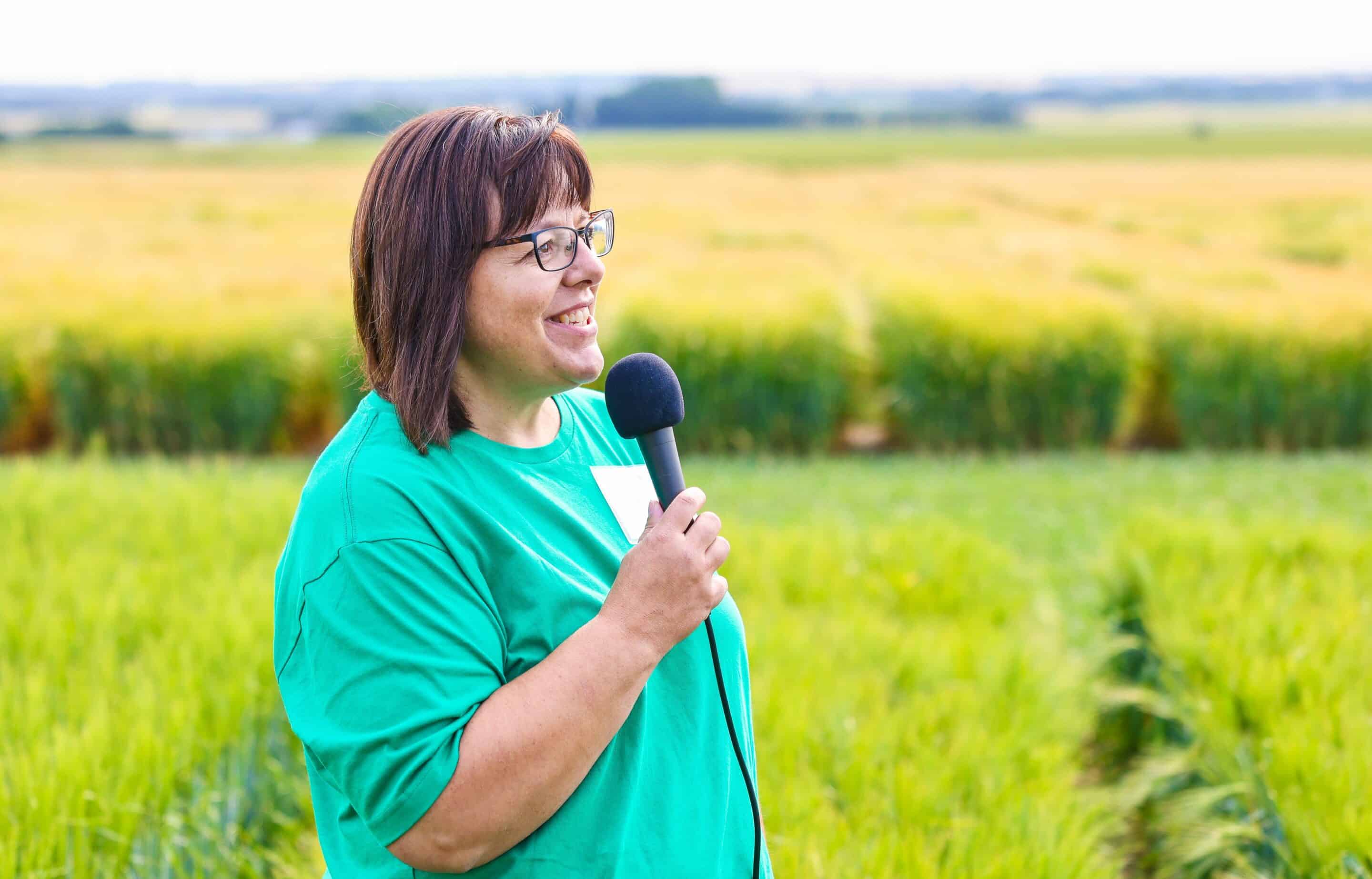A career in advancing near-infrared technology for Lori Oatway has made field crop development more efficient.
Most growers are familiar with near-infrared spectroscopy (NIRS) as a method of analyzing grain protein and moisture on-farm or at the elevator. Many researchers use the same technology to assess grain quality characteristics, but there’s a difference in Lori Oatway’s lab — she has taken it to the next level.
Oatway, who works as a research scientist at the Field Crop Development Centre (FCDC) at Olds College, has spent most of her 30-year career developing NIRS so it can be used to screen a significant number of samples for a wide variety of quality characteristics.
“I run the cereal testing program, so my main job is to produce data on all of the new varieties coming out into the industry to support end uses,” she says.
Oatway got her start in plant science as a summer student at the research station in Lacombe, Alta. while she was studying at the University of Alberta. She became a full-time technician after graduation and has since worked her way up the ladder in the technical program, including obtaining a master of science degree in using NIRS to detect toxins in barley and wheat.
Since the FCDC is home to breeding programs in malting barley, feed and forage barley and feed and forage triticale and grows over 36,000 plots per year, Oatway’s advancements in quality assessment efficiency have made a significant impact.
Evaluating Quality of Cereal Crop Varieties
Traditionally speaking, assessing quality has been done through wet chemistry analysis. To determine the malting quality of a barley sample, for example, the grain would be sent to a lab where researchers would produce malt by germinating it, letting it grow sprouts and drying it. The malt would then be processed and run through wet chemistry equipment.
“Over the last 25 years we have taken the wet chemistry on our varieties and used it to develop the equations we need in NIRS,” explains Oatway. “In the calibrations that we develop, every wavelength of light is absorbed by a different component in the grain.”
Ranging between 400 and 2,500 nanometers, the visible and infrared light scans a sample and records what was absorbed and what was reflected back. Various grain components can be predicted by knowing how much light was absorbed at what wavelength.

Lori Oatway is a research scientist at the Field Crop Development Centre at Olds College. Photo: Olds College of Agriculture and Technology
Since Oatway and her team have developed over 30 quality calibrations for barley alone, putting a whole grain in the instrument for 45 seconds produces absorption spectra and what she calls a “digital fingerprint” that can be used to estimate quality.
Given these developments, Oatway’s lab can process an impressive 400 samples per day. In comparison, it could take many months to run 50 samples using the traditional method of feeding trials to assess digestibility in cattle.
“NIRS is a great way to screen large numbers of samples,” says Oatway. “It’s very economical, non-destructive and it’s environmentally friendly because we don’t use any chemicals.”
But NIRS isn’t the only way quality is assessed at the FCDC. In fact, it’s a secondary method used to screen for potential that’s later confirmed by wet chemistry.
It takes about five generations to produce a head row, which is when quality testing begins. “There are a large number of samples but very low seed, so we assess all of the lines as a way of screening and throwing out the worst,” Oatway explains.
The screening process continues until there’s a more manageable number of samples in the program. Only those with the best potential are sent away for wet chemistry, which is a requirement for variety registration.
Oatway calls it a full circle process because as wet chemistry results come in, she adds the data back into her development program to either validate and update NIRS equations or to develop new ones.
“If we’re part of a project that is looking at gas production in cattle and we’re providing 100 different varieties of barley to be assessed, I can use the data on all 100 samples to see if we can produce a new equation. If we can, we are able to start screening for it without doing the live animal feeding trials,” she says.
Practical Expertise for Plant Breeding
Research scientist and barley breeder Yadeta Kabeta, who has been working with Oatway since he joined the FCDC in 2008, says quality is a critical component of breeding and is especially important in malting barley and forage barley.
“The quality assessment work that Oatway does helps us make progress with several end-use quality traits that are desired by the industry,” he says. “Her expert opinion on grain and forage quality is taken into consideration when making decisions and it aids us in selecting and releasing the best varieties for farmers.”
In addition to her formal education, Oatway’s expertise also stems from practical experience as a pedigree seed grower. She joined her husband’s family business, Oatway’s Seed Farm near Clive, Alta. when they got married over 26 years ago.
Global Knowledge for Testing Crop Varieties
Oatway says she has been fortunate to have excellent mentors, access to training around the world and opportunities to train others throughout her career.
An experience that will forever stand out in her memory was when she was invited to become an expert with the International Atomic Energy Agency and travel to Lima, Peru. While she was there, she played a key role in setting up a NIRS lab for barley and quinoa quality testing and trained ag college staff and graduate students on how to improve their program.
“It was really exciting, and it was an eye-opener because I was in a developing country with peers who do the same thing we do in Canada, with a lot less resources and access to technology,” explains Oatway.
Despite the budget fluctuations the research program has experienced over the years, Oatway’s experience in Peru showcased how fortunate Canadian research scientists are to have opportunities to innovate.
Quality Testing Industry Outlook
Over the past three decades, she has seen many industry shifts that influence the way quality is assessed. In the malting barley sector, for instance, the influx of craft brewers created opportunities for developing new barley varieties with a different quality profile. Craft brewing uses more malt than sugar sources in the brewing process, which is better suited to malt with lower malt enzyme levels.
While the feed and forage industry has been slower to select on quality, Oatway sees that changing as the dairy and beef sectors recognize the science of grain quality more and more.
“When we start looking at the cost of inputs that are going into agriculture, we want to make sure that the quality of our products are exceptional,” she says, noting the way feeding grain to cattle influences production and environmental factors is much more sophisticated today than it was 30 years ago.
Since the FCDC moved to Olds College in 2021, it has been clearly communicated that science drives the breeding programs.
“There’s a lot of potential for us to make a really large impact on quality,” Oatway says. “Even if the feed industry doesn’t buy on quality, we can put a lot of different components into our new varieties that will improve performance on the farm and give producers more benefit for buying pedigree seed.”
Looking ahead, she sees a continued need for NIRS technology. The software developments in the last few years have expanded the capacity to store larger data sets, which has given her four times the amount of information than was previously available.
As technology continues to evolve and NIRS analyzers become smaller and more portable, she can see a time when growers will be able to use them on-farm to assess some of the grain quality components that her lab specializes in.
Header photo — Lori Oatway at the 2021 Lacombe Field Day. Photo: Olds College of Agriculture and Technology
Related Articles
Selecting a Variety with the Seed Guide
Yadeta Kabeta is Breeding Barley in the Heart of Cattle Country





